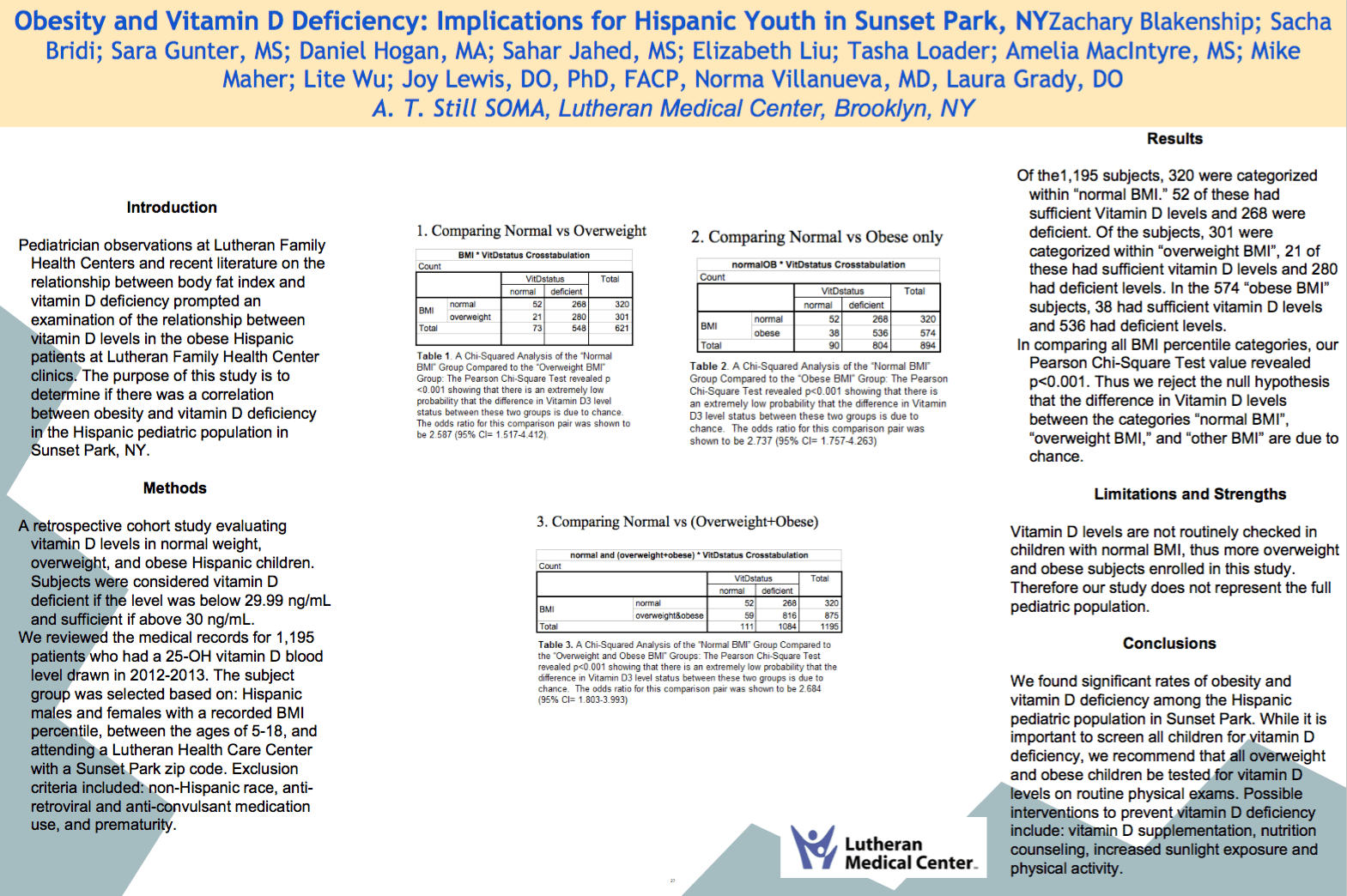Obesity and vitamin D deficiency
Implications for Hispanic youth in Sunset Park, NY
Students receive a premier education in osteopathic medicine at SOMA, which is fully accredited by the American Osteopathic Association Commission on Osteopathic College Accreditation (COCA).
In fact, 100% of SOMA Class of 2011 graduates were selected to participate in a post-doctoral internship or residency program upon completion of their D.O. degrees.
In addition to the Doctor of Osteopathic Medicine degree, SOMA students have the option to apply for dual degrees in Master of Health Administration, Master of Public Health, Master of Sciences, or Doctor of Health Education.
Purpose
The purpose of this study is to determine if there was a correlation between obesity and vitamin D deficiency in the Hispanic pediatric population in Sunset Park, NY. Pediatrician observations at Lutheran Family Health Centers and recent literature on the relationship between body fat index and vitamin D deficiency helped guide our methods.
Study Design
A retrospective cohort study evaluating vitamin D levels in normal weight, overweight, and obese Hispanic children. Subjects were considered vitamin D deficient if the level was below 29.99 ng/mL and sufficient if above 30 ng/mL. We reviewed the medical records for 1,195 patients who had a 25-OH vitamin D blood level drawn in 2012-2013. The subject group was selected based on: Hispanic males and females with a recorded BMI percentile, between the ages of 5-18, and attending a Lutheran Health Care Center with a Sunset Park zip code. Exclusion criteria included: non-Hispanic race, anti- retroviral and anti-convulsant medication use, and prematurity.
Data collection and analysis
Patient information was obtained through eClinicalWorks electronic medical records at Lutheran Medical Center.
Results
Of the1,195 subjects, 320 were categorized within “normal BMI.” 52 of these had sufficient Vitamin D levels and 268 were deficient. Of the subjects, 301 were categorized within “overweight BMI”, 21 of these had sufficient vitamin D levels and 280 had deficient levels. In the 574 “obese BMI” subjects, 38 had sufficient vitamin D levels and 536 had deficient levels. In comparing all BMI percentile categories, our Pearson Chi-Square Test value revealed p<0.001. Thus we reject the null hypothesis that the difference in Vitamin D levels between the categories “normal BMI”, “overweight BMI,” and “other BMI” are due to chance.
Limitations
Vitamin D levels are not routinely checked in children with normal BMI, thus more overweight and obese subjects enrolled in this study. Therefore our study does not represent the full pediatric population.
Conclusions
We found significant rates of obesity and vitamin D deficiency among the Hispanic pediatric population in Sunset Park. While it is important to screen all children for vitamin D deficiency, we recommend that all overweight and obese children be tested for vitamin D levels on routine physical exams. Possible interventions to prevent vitamin D deficiency include: vitamin D supplementation, nutrition counseling, increased sunlight exposure and physical activity.
Sources
1. Lenders CM, Feldman HA, Scheven EV, et al. Relation of body fat indexes to vitamin D status and deficiency among obese adolescents. The American Journal of Clinical Nutrition. Vol 90:3, 2009
